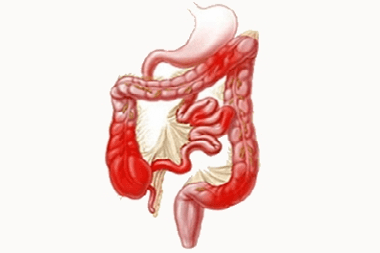Digestive system >>>> Ileitis - signs and treatment of the disease
Ileitis - signs and treatment of the disease.

Ileitis is an inflammatory disease of the predominantly ileal part of the small intestine and the initial part of the large intestine. In the medical literature it is found under the names: "Crohn's disease", "terminal ileitis", "granulomatous enteritis". There are several opinions about the origin of this disease, the most common of which are:
- Genetic predisposition to the development of ileitis;
- The autoimmune nature of the disease;
- Violation of the body's immune responses due to infection (yersiniosis, giardiasis, salmonellosis and others).
The inflammatory process in ileitis affects all layers of the intestinal wall, proceeds with the formation of erosions, granulomas, ulcers, cracks, polyps, fistulas, scars. For ileitis, the inflammatory process is limited, which leads to segmental intestinal lesions, where foci of inflammation are adjacent to healthy areas of the intestine.
The affected intestinal wall thickens in size, which leads to a narrowing of the intestinal lumen in the affected segment and impedes the passage of food masses, causing additional injuries. Intestinal stenosis is also triggered by the formation of scar tissue, which leads to impaired patency of the affected areas of the intestine.
In addition to the narrowing of the intestinal lumen, with ileitis, there are disturbances in the function of absorption of nutrients, and the result of such disturbances is weight loss (up to anorexia), indigestion in the form of diarrhea, flatulence.
The characteristic signs of ileitis are:
- Abdominal pain after eating,
- Pain in the iliac region simulating pain appendicitis,
- Nausea, urge to vomit;
- Weight loss, impaired appetite, up to refusal to eat;
- Violation of general well-being, weakness, low-grade fever;
- The wavy nature of the symptoms.
In addition to the defeat of the intestinal walls with ileitis, work in different systems of the body is disrupted, which manifests itself:
- From the oral cavity - aphthous stomatitis,
- On the part of the skin - pyoderma, erythema, angiitis,
- On the part of the musculoskeletal system - ankylosis of the joints, monoarthritis,
- From the liver and biliary tract - cholangitis, fatty degeneration of the liver,
- From the urinary system - cystitis, pyelonephritis, nephrolithiasis.
When diagnosing the disease, endoscopy, colonoscopy (ileocolonoscopy) are used, biopsy, X-ray examination with a radiopaque substance, MRI of the intestine, electrogastroenterography, immune analysis for the presence of markers - antibodies to a fragment of the cell wall of Saccharomyces cerevisae, analysis for the presence of immunoglobulins of the IgA class.
Depending on the expected nature of the onset of the disease, approaches to the treatment of ileitis differ. If an infectious cause of the development of the disease is suspected, antimicrobial, antiparasitic therapy is performed with a preliminary determination of the sensitivity of microorganisms to drugs. The basis of drug therapy is anti-inflammatory drugs (corticosteroid drugs, for example, Budenofalk), Sulfasalazine and its analogs (with caution), Mesalazine. Conjugated linoleic acid has proven itself well. Conservative treatment of ileitis aims to lengthen the period of remission of the disease.
A prerequisite for the treatment of ileitis is considered to be a diet that excludes the intake of coarse-fiber foods (so as not to injure the intestinal walls), rich in easily digestible components. Enzyme preparations, astringent herbal remedies, probiotics help to normalize digestion. Ileitis, as a rule, is of a chronic nature, for this reason, the diet must be followed during periods of relapse, and during periods of remission, do not overload the gastrointestinal tract with heavy food (fatty, fried foods, canned and smoked foods, alcoholic beverages).
Surgical treatment of ileitis is indicated for the development of intestinal obstruction, the formation of fistulas, bleeding, and the development of an abscess. The affected segments of the small (or large) intestine are excised. With an abscess, an incision is made in order to create an outflow of purulent contents.

Read

Read



























